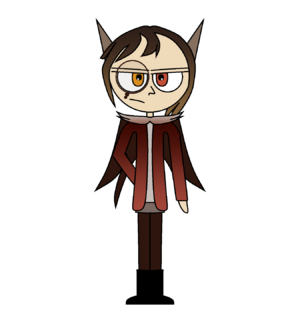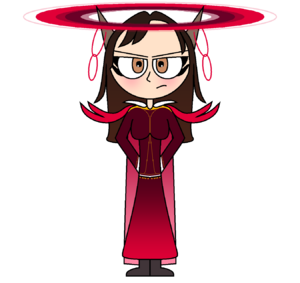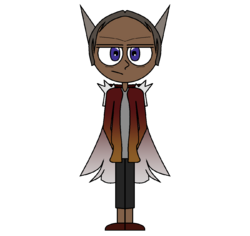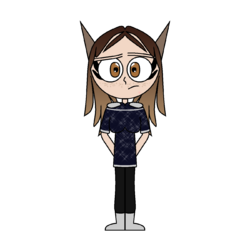Aerlon


Aerlons (Palaeroni aerlon; until 1996 Novaerlontis monenova) are a species of humanoid lifeforms belonging to the Tertanian Tamaea kingdom. They are the most numerous type of tamaea, numbering almost four trillion individuals as of the year 2100. Aerlons are primarily distinguished for their bipedalism and complex brains amongst other things unique to their species. Their society has evolved into complicated sociological systems, structures, and norms on a wide range of magnitudes from families and romantic relationships to entire governments and nations that span across continents, planets, or even entire star systems or several star systems. They are directly descended from the now extinct Palaeroni species, who died out roughly 2 billion years ago.
Modern aerlon civilization first emerged within the Polytinaris System about 900,000 years ago, with the extant aerlon species (P. aerlon monenova) having evolved from a similar species (likely P. aerlon pipponasis) within the Santrian region of the Tertanian Vardellum supercontinent. By about 150,000 years ago they had spread to the planet's other landmasses such as Wysouth and Daunjey. Advanced civilizations past the hunter-gatherer way of lifestyle dates back about 80,000 years, at which point the aerlons began developing numerous traits of behavioral modernity - these ranged from fairly primitive tasks such as farming & building permanent settlements to grander-scale achievements, culminating in their current status as a spacefaring interstellar species.
Biology
In general, aerlons bear a marked resemblance to the human species of the planet Earth: a profound example of convergent evolution, as the two species are actually separated by tens of thousands of light years and exist in totally different locations of the Milky Way Galaxy. A symmetrical body plan is followed by their appendages, with aerlons possessing two arms, legs, eyes, ears, and nostrils (in addition to breasts, for female individuals) - . Aerlons have a rounded head, attached by neck to their torso, which houses an aerlon's major organs and body systems. Above their eyes are a set of twin layered eyebrows. Most aerlons can furrow the top eyebrow independently from the lower one, but this is not always the case and is based on hereditary genetics.
The most outwardly apparent difference between humans and aerlons is their ears. An aerlon's ears are large, triangular (shaped similarly to that of a cat or fox), and attached to the top of their head, unlike human ears which are mounted on each side of their head. Aerlons have a significantly more acute sense of hearing compared to humans and are able to hear sounds of much higher frequencies. The ears are usually a medium brownish-gray color, although it is not uncommon for them to be frosted (have their edges dyed a certain color). Aerlon ears are quite fragile, however, and can be easily torn, causing hearing difficulty and loss if not properly treated.
Life cycle


Just like humans, aerlons are born live and from a female parent. The average gestational period for an aerlon mother is slightly shorter than a human, being on average around 8 months long. The child is born almost helpless and requires constant attention to ensure healthy development. Developmental milestones (i.e., the ability to walk, talk, etc.) have usually been reached by age 5. Adolescence begins for aerlons at around age 20 and lasts until age 35, at which point they are considered to have reached full sexual maturity. The legal age of majority for an aerlon is at 40 years of age.
The lifespan of an aerlon is much longer than a human’s. Aerlons age over two times slower than humans; as such, an aerlon that is 100 years old will look younger than even a 50-year-old human. The typical life expectancy of an aerlon at birth is between 190 and 250 Earth years (about 210 to 280 Tertanian years), though this can vary widely depending on the individual’s living conditions, lifestyle, genetic factors, etc. Unlike humans, neither sex of aerlon has a noticeably longer lifespan than the other. Aerlons living more than approximately 275 years is very uncommon, although there have been a handful who have lived to over 300. Signs of old age in the aerlon species include graying hair & ears, facial wrinkles, and difficulties with memory processing and vision.
Gender and sex
Two different biological sexes of aerlons exist: male and female. A very select few are born with characteristics of both sexes, being intersex. These form the traditional gender binary in aerlon society & culture, although in recent times this has become less defining of their behavior thanks to progressive legislation and gender equality/expression movements: in recent years as much as 13% of the entire aerlon population did not identify with the gender they were assigned at birth. Gender variance, nonconformity, and non-assigned gender identities also exist: some of the more well-known alignments include transgender (individuals who identify as the opposite sex to which they were born as) and non-binary (an umbrella term that can mean any aerlon whose identity corresponds to one outside of the binary). A notable transgender/non-binary aerlon is Quevestin Garmania.
Genetic variations, disorders, and mutations

Aerlons come in many different genetic varieties and can have significant degree of difference from one another. Height and body size is not uniform amongst aerlons: on average, most individuals born on the planet Tertan are between 5 and 6 feet tall, however they can be much larger or smaller than this. Males tend to be larger than females; their height leans more towards the upper end of the average range. Body weight is also not uniform - in general, males tend to be heavier than females.
Most aerlons are white. Unlike humans, skin color is not as varied amongst aerlons, but darker individuals do exist. Most darker-skinned persons are medium or caramel brown, but black aerlons do also exist. Skin color is heavily influenced by the environment of the celestial body the aerlon was born on: those born on hot, sunny planets tend to have darker colors than those native to cloudier and cooler worlds.
Aerlons can have a wide range of eye colors running the full ROYGBIV color spectrum. The most common color is brown, followed by green, blue, and purple. Yellow and red are somewhat uncommon, as is orange. Pink-colored eyes are the rarest. A very small percentage of the population possess heterochromia, or contrasting colors in their eyes.
Aerlon hair is colored very similarly to that of a human’s - it can be brown, blonde, black, ginger, or red. Some aerlons are born with completely gray hair. Hair dyeing is very prevalent amongst society, allowing for a wide range of vibrant colors also running the full spectrum that otherwise wouldn’t appear naturally.
Many aerlon developmental divergences exist, and are quite normalized thanks to progressive social movements and legislation. Some examples of these include autism and Down syndrome.
Culture and society
Clothing


Like humans, all aerlons wear various forms of clothing. Most aerlon men wear long-sleeved shirts and/or sweaters along with a pair of pants depending on the climate of their home planet/moon. Aerlon women typically wear dresses or a jacket & skirt, also depending on weather. This is not the norm, however, and all sorts of different styles of aerlon clothing exist in all shapes and sizes. Body piercings, such as ear and nose rings, are also sometimes used by members of the aerlon species. It is also a somewhat common plastic surgery for aerlons to have their ears artificially enlarged as a stylistic choice.
Two forms of aerlon fashion are unique to their species. The first form of this is a variation of a cape that is wide and shaped similarly to a set of wings, most often worn by individuals in the military and mostly popularized by the Great Quartet member Hanelia Siaena. The second is a large ring worn over their head similarly to a crown or tiara, that looks like a planetary ring system. The head ring appears to be floating but in reality is attached by extremely transparent pieces of plastic, which clip onto their ears or are worn like a headband. This is usually only worn by people in positions of power.
Technology

Aerlon society is quite advanced in its complexity. The technology of the aerlon species has produced many great inventions ranging from fairly workaday items such as electricity and running water to extremely advanced items not even humans possess, including terraforming devices, FTL-capable starships, and weapons of mass destruction capable of leveling entire planets. On the Kardashev scale, they rank somewhere around the lower-end Type II range, controlling energy, resources, and space on the scale of a few dozen star systems.
Politics
A notable trait of the aerlons are their systems of national government and ideology, which forge nations on a variety of scales (planetary, system-wide, or even interstellar). The most notorious aerlon nation is the Tessian Hegemony, a brutish, far-left socialist dictatorial regime ruled by Tessia von Gretolia, a female aerlon. At its apex during the second half of the 21st century, it had supreme authority over 47 solar systems and subjected hundreds of billions of other aliens to slavery, segregation, and other forms of discrimination. It emerged in the year 1998 after a successful revolution against the previous aerlon nation, the Polytinaris Commonwealth, and existed for more than a century until meeting its end in 2122 at the hands of the non-aerlons it oppressed greatly. The currently incumbent aerlon government is the Stellar Commonwealth.